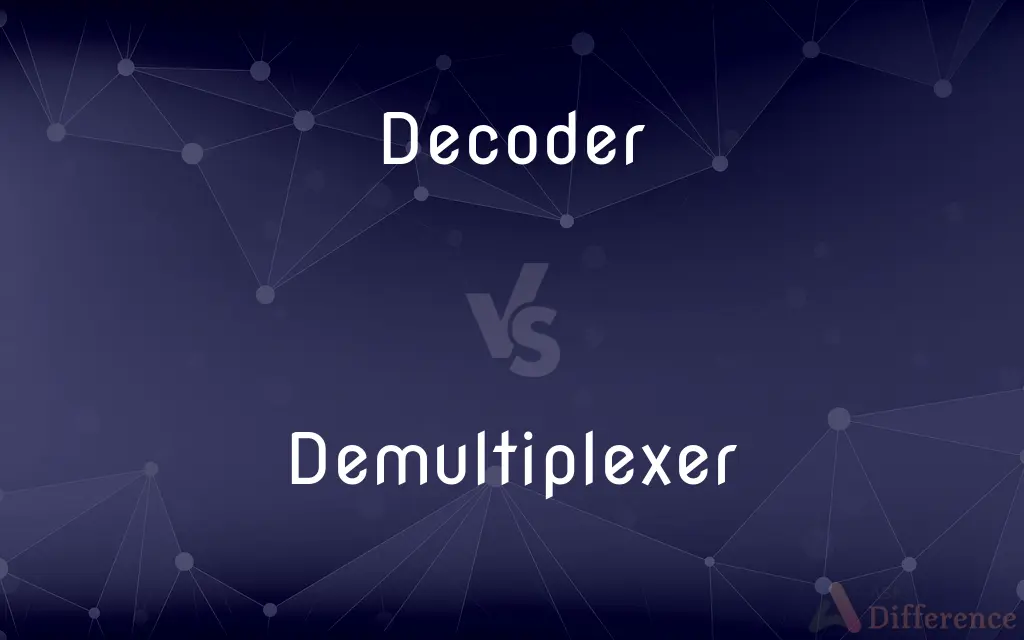Decoder vs. Demultiplexer — What's the Difference?
By Maham Liaqat & Fiza Rafique — Updated on May 8, 2024
A decoder converts binary data into a specific output, enabling data interpretation, while a demultiplexer distributes a single input signal across multiple outputs.

Difference Between Decoder and Demultiplexer
Table of Contents
ADVERTISEMENT
Key Differences
A decoder is a device that translates binary coded data into a unique output, aiming to simplify communication and processing in digital circuits. On the other hand, a demultiplexer takes a single input signal and routes it to one of many outputs, depending on the selector inputs.
In function, decoders are often used to decode encoded information into a more understandable or usable form, crucial in applications like data retrieval and signal processing. Conversely, demultiplexers are pivotal in channel routing scenarios where multiple output lines are controlled by a single input source.
Decoders typically have multiple input lines and exponentially more output lines, used to activate exactly one of the outputs based on the input combination. Whereas demultiplexers have fewer control inputs and several output lines, selecting only one output at a time for signal transmission.
Error handling in decoders involves checking the correctness and completeness of the output states. In contrast, demultiplexers focus on the accurate switching and transmission of signals without loss or interference.
While decoders are integral in digital electronics for device selection and data de-encryption, demultiplexers serve primarily in communication systems to manage signal distribution efficiently across different channels.
ADVERTISEMENT
Comparison Chart
Primary Function
Converts coded data to specific outputs
Routes signals to one of many outputs
Input Type
Binary code
Single signal with selector inputs
Output Complexity
Multiple outputs, one active at a time
Multiple outputs, selected by control
Usage Examples
Digital displays, memory address decoding
Data streaming, signal routing
Error Handling
Checks output correctness
Ensures accurate signal transmission
Compare with Definitions
Decoder
A tool in communication systems to revert signals from a coded form.
Satellite receivers use decoders to convert incoming signals into viewable TV channels.
Demultiplexer
An essential component in communication for channel selection.
Broadcasting equipment uses demultiplexers to manage multiple broadcast streams.
Decoder
A hardware used to select one out of multiple outputs.
A 3-to-8 line decoder activates one of eight outputs based on three input signals.
Demultiplexer
A device that sends signals to one of many outputs.
A demultiplexer in a home theater system routes audio signals to different speakers.
Decoder
A device that translates encoded data into a more usable form.
A binary decoder converts binary digits into corresponding decimal outputs.
Demultiplexer
Used in data handling to distribute a single data input.
Network switches use demultiplexers to route data packets to appropriate ports.
Decoder
An electronic component used in digital circuits to interpret signals.
The decoder in the DVD player interprets the data into video and audio output.
Demultiplexer
Utilized in digital circuits for effective data management.
A demultiplexer can distribute data among several processing units in a computer.
Decoder
A device that reconstructs information to its original form.
Network routers include decoders to process incoming data packets.
Demultiplexer
A tool for splitting signal paths in electronic systems.
In surveillance systems, demultiplexers direct video feeds to different monitors.
Decoder
One that decodes.
Demultiplexer
A device or piece of software used to separate signals that were previously combined using a multiplexer.
Decoder
A device that decodes a scrambled electronic signal to make it interpretable.
Decoder
A person who decodes secret messages
Decoder
A device that decodes a scrambled electronic signal e.g. of a satellite television signal
Decoder
The kind of intellectual who converts messages from a code to plain text
Decoder
A machine that converts a coded text into ordinary language
Common Curiosities
Can a decoder and a demultiplexer be used together?
Yes, they can be used in sequence to decode and then distribute a signal appropriately.
What is a common application of a decoder in electronics?
Decoders are widely used in digital display systems to interpret binary data into displayable information.
How does a demultiplexer work in a communication system?
It selects one of many output channels based on the input selector signal.
What role does a demultiplexer play in network routers?
It helps in distributing incoming data signals to the correct output lines based on addressing information.
What is the primary function of a decoder?
To convert encoded data into a recognizable and specific output format.
How do decoders contribute to computer memory systems?
They decode address lines to select specific memory cells.
How do input and output differ between a decoder and a demultiplexer?
A decoder often handles complex coded inputs to produce simpler outputs, while a demultiplexer manages one key input to multiple outputs.
What is a key difference in the error checking mechanisms between decoders and demultiplexers?
Decoders focus on decoding accuracy, while demultiplexers emphasize correct signal routing.
Can demultiplexers be used in analog systems?
Yes, demultiplexers are also functional in analog systems for routing various signal types.
Is error handling more critical in decoders or demultiplexers?
Both devices require precise error handling for their functions, although the specifics may vary based on their roles.
What makes a decoder essential in digital communication?
It ensures that data transmitted in coded form can be accurately interpreted and utilized.
Why is a demultiplexer vital in signal routing applications?
It enables efficient management of multiple output lines from a single signal source.
What is an example of a decoder in daily technology use?
In remote controls, to decode signals sent to televisions.
How does the complexity of a decoder’s design compare to that of a demultiplexer?
Decoders often have more complex design requirements due to the need to handle multiple types of data interpretation.
How do demultiplexers enhance the functionality of digital systems?
By allowing flexible routing of signals to multiple destinations without signal interference.
Share Your Discovery

Previous Comparison
Sing vs. Chant
Next Comparison
Pentagram vs. PentacleAuthor Spotlight
Written by
Maham LiaqatCo-written by
Fiza RafiqueFiza Rafique is a skilled content writer at AskDifference.com, where she meticulously refines and enhances written pieces. Drawing from her vast editorial expertise, Fiza ensures clarity, accuracy, and precision in every article. Passionate about language, she continually seeks to elevate the quality of content for readers worldwide.
















































